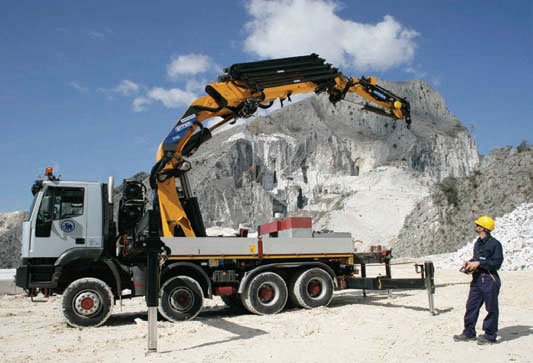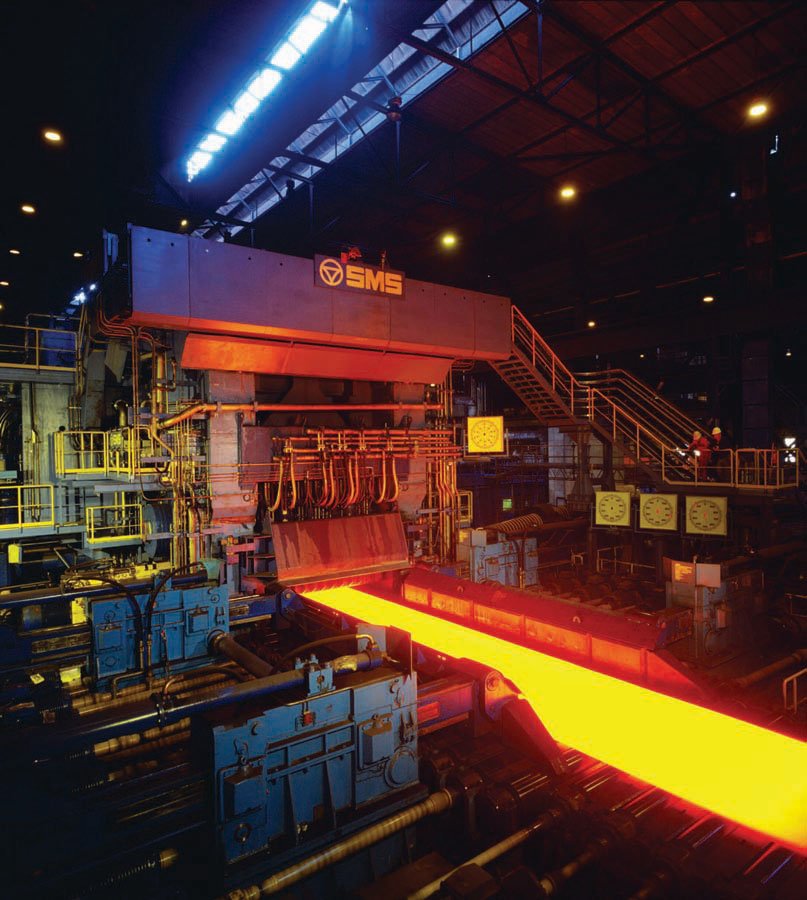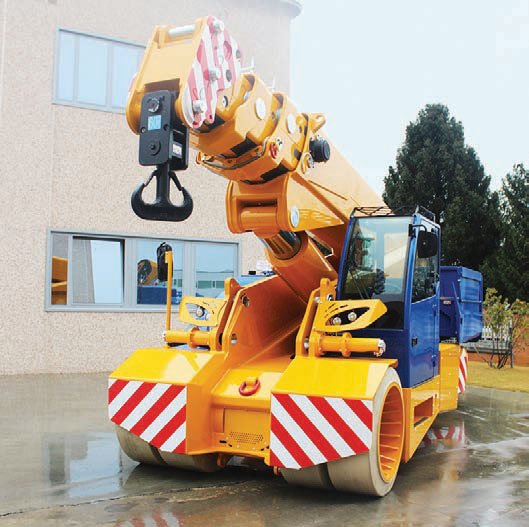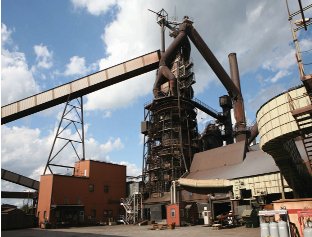Your flexible friend
19 July 2017Sotiris Kanaris visits SSAB’s steel plant in Oxelösund, Sweden, and looks into the development of the strong, flexible steels used in mobile and loader crane booms.
Arriving at SSAB’s Oxelösund plant, one’s attention is instantly captured by the gigantic blast furnace, which seems wrapped in innumerable pipes of different sizes. In the same facility there is a steel mill, rolling mill, and quenching line.
The plant was built in 1914. At the beginning, its main customer was the shipbuilding industry. In the late 1960s and early 1970s it became one of the fi rst sites worldwide where quenching and tempering were investigated, triggering the development of various steel materials.
Today SSAB has clients from a wide range of industries and has an annual steel production capacity, across all its factories, of 8.8 million tonnes. The crane industry uses SSAB’s Strenx series of highstrength, high-performance steels for the manufacture of crane booms.
Not all booms are made using the same steel material; it can vary in terms of yield strength and thickness to meet each crane manufacturer’s requirements. SSAB offers Strenx 700, 900, 960, 1100, 1300, with the number indicating the yield strength of the material in megapascals (MPa).
Per Hedmark, technical development manager in Germany at SSAB, said: “30–40 years ago, the maximum yield strength was 700MPa. Every ten years we made a step forward to reach 900, 960, 1100, 1300MPa. Also the properties of quality and bendability have slowly and steadily improved. The maximum thickness in every grade has slowly climbed up.”
Hedmark has a close relationship with a number of German mobile crane manufacturers that SSAB does business with. He says they have been requesting higher grades over the years.
“They wanted to make lighter booms or be able to lift more with the same vehicle weight, therefore they were requesting a higher grade in order to reduce the thickness. They also want tight thickness tolerances, because they have to calculate the weight with the nominal or medium thickness, but they have to do the stress analysis with the minimum thickness. The smaller the gap, the better they can do these calculations,” he explained.
He says the most popular material for smaller mobile cranes is the 1100, while for the bigger ones it is 1300. Mobile crane manufacturers use different grade combinations to optimise the booms.
Hedmark says axle and gross vehicle weight regulation pressures in Europe are pushing manufacturers to use higher grades, while in the US they use 700 material even in the most advanced applications.
David Diaz, technical development manager for Italy, Switzerland and Greece at SSAB, says for loader crane booms the most popular product is the Strenx 1100, but many are using the 700 and 960.
Diaz says: “It depends a lot on the type of crane, as there are many kinds of cranes for different applications. You have those ones that are really long and have a long reach, and those that are short and very powerful. But we see more and more manufacturers choosing the 1100 material.”
Among SSAB’s clients are a number of Italian loader crane manufacturers. One, Effer, was actually the driving force behind the development of Strenx 1300. “If you want to have a bigger crane that reaches longer and lifts more, the only way to do it is by reducing the thickness of the material used further away from the base of the crane. In order to do that you need a stronger material and that is why Effer needed the 1300 material,” Diaz explains.
Diaz says SSAB has close collaboration with loader manufacturers, as they want to know the properties of the materials when designing their cranes. “They are very much interested in what happens when you weld the material, which heat input you can use and which is the resultant strength of the welds.”
In Europe, the general design principles for cranes are defined by the norm EN13001. Diaz says that SSAB worked with crane manufacturers to review the fatigue calculations used in the standard. Limit states and proof competence of steel structure for cranes is covered in part EN 13001-3-1 of this multipart standard.
Both technical development managers were optimistic about the performance of the crane industry in the near future and therefore the demand for relevant SSAB products. They said there are major infrastructure projects in the pipeline in Europe and an expansion of European crane manufacturers’ activity in the Middle East and Africa.
To the question whether there are plans for developing Strenx 1500, they answered that there have been discussions but the demand for it is not there yet. “We are now focusing on making better properties, thicker plates on the high grade and developing the strip material,” says Hedmark.
Steel prize
This year the annual Swedish Steel Prize attracted 102 applications, the highest number since its launch in 1999. Over these years, companies have been awarded for their innovative products, methods and processes utilising high-strength steel.
Among the four finalists this year was JMG Cranes, for its new MC580 electrical pick and carry crane. JMG used Strenx 700 with a width of 12mm to implement the crane’s extendible rear chassis, and for the removable stabilisers with widths of 15, 30 and 60mm. JMG chose two types of Strenx for the boom, the ultra-high-strength Strenx 900 with thicknesses of 8, 10, 12mm; and the Strenx 700 with thicknesses of 12 and 30mm.
Through the use of these materials, JMG reduced the overall weight of the MC580 from 42.5t in configuration of maximum performance to 27.9t without ballasts, stabilisers and hoist and a further reduction is possible up to 23.6t by removing the battery.
Diaz says it was the first time a 900 material was used in a crane of this type. “In those cranes usually 700 is more than enough, because you don’t really care how much the overall machine weighs. In this case it is an electrical crane and they wanted to make it suitable for transport on a normal truck, so it had to weigh under 24t disassembled.” The winner of the Swedish Steel Prize 2017 was Kiruna Wagon for its dumper wagon system for long-haul railroad transportation and efficient unloading of materials.
In 2015, Terex Cranes was nominated for the award for its adaptable crane section, known as the Boom Booster. As this article was being written, Terex announced a new generation of the Boom Booster, allowing the increased-strength sections to be used all the way down to the foot of the boom, and offering even higher lifting capabilities.
Sustainable steelmaking
The steel manufacturing process has remained the same for more than a thousand years; an effect of this process is high greenhouse gas emissions. SSAB CEO and group manager Martin Lindqvist says reducing greenhouse gases is one of the biggest challenges facing the industry.
Linqvist says that through a number of measures, SSAB has become the most carbon dioxide effective steel producer globally. However the company is conducting research for a process of ironmaking that will be carbon dioxide emission free.
SSAB has launched an initiative alongside Swedish mining company LKAB and power company Vattenfall to solve the carbon dioxide issue in the Swedish steel industry. The project’s goal is to come up with a process that emits water instead of carbon dioxide by using hydrogen instead of the current procedure that is based on blast furnaces burning coal and coke.
The initiative is divided into three phases: a pre-feasibility study that will run through the end of 2017, followed by research and testing in a pilot plant through 2024, and the final step, which involves carrying out testing in a full-scale demo plant through 2035.
The Swedish Energy Agency decided to provide more financing for the initiative for a carbon-dioxide free steel industry. The country has pledged to cut all greenhouse gas emissions by 2045.
 SSAB’s highest strength steel plate for cranes, Strenx 1300, was first developed for Italian knuckleboom manufacturer Effer.
SSAB’s highest strength steel plate for cranes, Strenx 1300, was first developed for Italian knuckleboom manufacturer Effer.
 A rolling mill is needed in order to produce heavy plate. The thick, heavy steel slabs must be rolled out to become plates of the right thickness and width. SSAB’s Swedish rolling mill for heavy plate, located in Oxelösund, works with forces of 100,000 kN (10,000 tons) and it is one of the strongest in the world.
A rolling mill is needed in order to produce heavy plate. The thick, heavy steel slabs must be rolled out to become plates of the right thickness and width. SSAB’s Swedish rolling mill for heavy plate, located in Oxelösund, works with forces of 100,000 kN (10,000 tons) and it is one of the strongest in the world.

